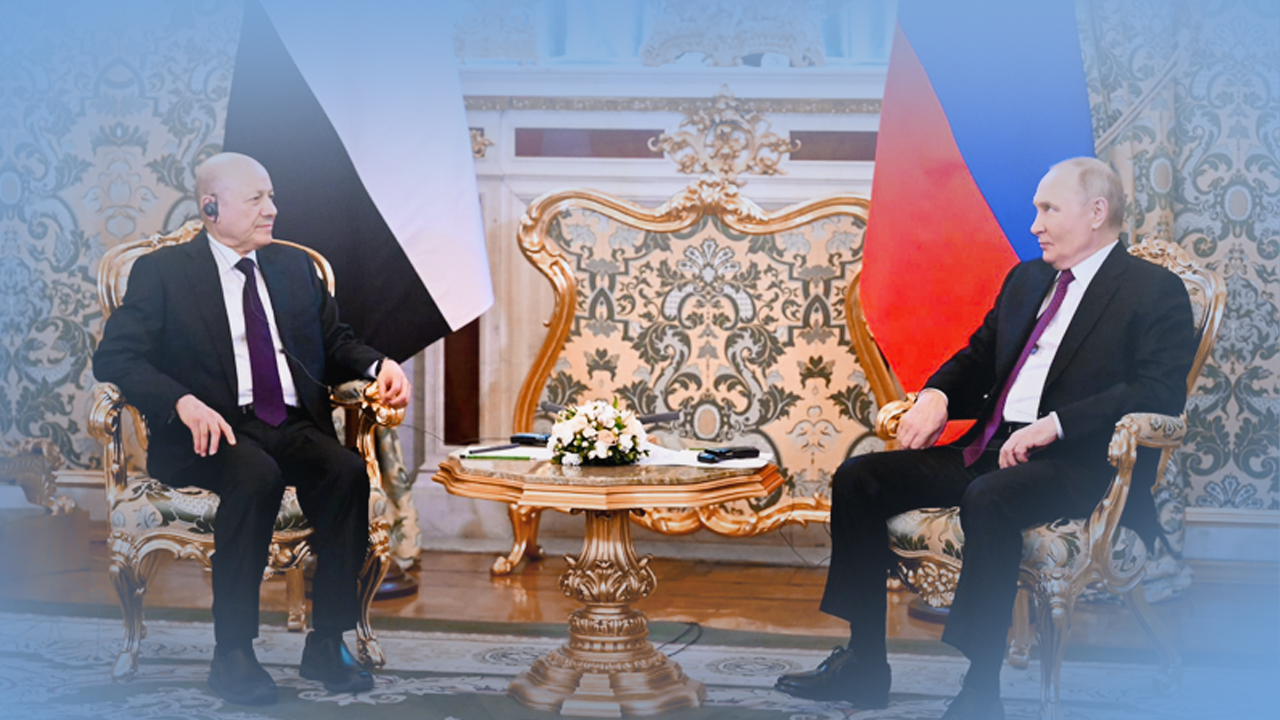Monthly Briefing/ April – 2025

| Getting your Trinity Audio player ready... |
Political Scene:
The Yemeni landscape is experiencing rapid developments on political, military, and diplomatic fronts amid increasing international pressure on the Houthis and intensified regional and global efforts to revive the stalled peace process. The internationally recognized government continues to assert its legitimacy and broaden its foreign relations against a backdrop of shifting international dynamics.
- Saudi Defense Minister Prince Khalid bin Salman visited Tehran, accompanied by the Kingdom’s ambassador to Yemen, Mohammed Al-Jaber, to discuss the Yemeni file within the framework of the Saudi-Iranian reconciliation agreement. The visit coincided with heightened U.S. pressure on the Houthis. April 18
- The European Union’s “Aspides” naval mission announced it had provided protection to more than 750 commercial vessels in the Red Sea since its launch in February 2024, in response to Houthi attacks on international shipping.. April 20
- UN Special Envoy for Yemen, Hans Grundberg, held meetings in Muscat with Houthi representatives and diplomats as part of efforts to promote the political and humanitarian peace process. April 24
- YYemen’s Ministry of Foreign Affairs announced the resumption of embassy operations in Syria, appointing Counselor Mohammad Azzi Ba’ker as Chargé d’Affaires, following years of Houthi control over the embassy. April 25
- The Houthi group claimed that U.S. airstrikes on the “Ras Issa” port had injured three Russian sailors, accusing Washington of preventing the unloading of an oil shipment. April 26
- The U.S. Department of the Treasury imposed new sanctions on three ships and their companies for supporting the Houthi group by delivering oil derivatives to Houthi-controlled ports. April 28
- The head of the Supreme Council of the Popular Resistance, Sheikh Hamoud al-Mukhlafi, held a virtual meeting with Japanese Ambassador “Yoichi Nakashima,” appreciating Japan’s support for Yemen and discussing the role of the resistance and the call for intensified support for the legitimate government. April 29
Russia confirmed that three Russian sailors were injured in a U.S. airstrike on the Houthi-controlled “Ras Issa” port, one of whom was transferred to a hospital in Sana’a and may undergo surgery, while the other two had minor injuries. April 30
Military Scene:
Military operations in Yemen intensified in April, as the United States expanded its air campaign against Houthi leadership and strategic infrastructure. The escalation contributed to a significant decrease in Iranian naval activity in the Red Sea. These strikes are part of a broader strategy to weaken the Houthis’ military capabilities and coincide with statements from the former Yemeni Minister of Defense, who affirmed the national army’s readiness to initiate ground operations if required.
- U.S. President Donald Trump released a video showing an American airstrike on a Houthi gathering in Hodeidah. The Yemeni Minister of Information later confirmed that the April 2 strike south of Al-Faza killed 70 Houthis, including Iranian leaders and military experts. April 5
- The Houthi movement acknowledged the death of Abdulrahman Al-Dharafi, head of the “educational sector” in Saada, in a U.S. airstrike in early April, and published images from his funeral. April 14
- The Maritime Executive reported the likely withdrawal of the Iranian naval ship Nudaja from the Red Sea and Gulf of Aden, noting its absence since March 2025. The move coincides with a rising U.S. military buildup that could affect Houthi maritime intelligence support. April 15
- The United Arab Emirates and Saudi Arabia denied reports of their involvement in talks with the United States regarding a possible ground offensive against the Houthis. April 17
- U.S. fighter jets launched 46 airstrikes on Sana’a, Al-Hudaydah, Amran, and Ma’rib, killing 3 people and injuring 7. The strikes hit residential areas and strategic facilities, including cemeteries and military positions. April 19
- The U.S. and the U.K. conducted joint airstrikes targeting Houthi facilities south of Sana’a, said to be used for drone manufacturing threatening Red Sea shipping. This marked the first British acknowledgment of participation in the strikes since mid-March. April 20
- Former Yemeni Defense Minister Lt. Gen. Mohammed al-Maqdashi stated that the Yemeni army is prepared for ground combat against the Houthis and is awaiting a political decision. He denied any internal disputes among the legitimate forces and noted that while U.S. airstrikes have hurt the Houthis, ground operations are needed for a decisive outcome. He also accused Omani parties of smuggling weapons to the group. April 21
- The U.S. military denied responsibility for an explosion in Sana’a’s Farwa Market, attributing it instead to a Houthi missile. The explosion killed 12 and injured 34. April 25
- U.S. jets carried out a new wave of airstrikes targeting suspected Houthi locations in Sana’a, Sa’dah, Al-Jawf, Ma’rib, and Al-Hudaydah. According to Houthi media, 8 civilians were injured.. April 26
- The Houthi group claimed a U.S. airstrike hit a prison in Sa’dah, killing 68 African migrants and injuring 47 others. April 28
The United States announced the loss of seven MQ-9 Reaper drones, each worth $30 million, since last March during operations in Yemen. The drones had been used for surveillance to locate Houthi weapons. April 30
Security scene:
The United States continues its heightened escalation against the Houthis through airstrikes and financial sanctions targeting the group’s funding and arms networks, in an effort to deter their actions and end their threats to international shipping in the Red Sea.
- Houthi security leader Mohammed Jiash was killed along with his two brothers and several companions in a U.S. airstrike in Hudaydah Governorate, as part of the American escalation against the group. April 3
- The United States reaffirmed its commitment to halting Houthi activities and restoring freedom of navigation in the Red Sea, while targeting their financial sources through sanctions on oil derivatives. This followed a UN breach of the embargo that allowed a fuel tanker into Ras Isa port, with exemptions made only for food and medicine. April 9
- The Houthi-affiliated Ministry of Health reported that 61 civilians had been killed and 139 wounded in U.S. airstrikes on Houthi positions since March 15, bringing the total number of civilian casualties to 200. April 2
The U.S. Treasury Department imposed sanctions on the International Bank of Yemen and three of its officials, accusing them of supporting the Houthis and helping them gain access to the international financial system. April 17
Economic Scene:
Yemen’s economic crisis deepened in April, as the Yemeni riyal suffered a sharp decline and the government struggled to implement effective stabilization measures. U.S. sanctions on Houthi financial networks—especially those linked to Saeed al-Jamal—further constrained funding sources and heightened financial strain. The disputed entry of a sanctioned fuel tanker into Ras Isa port also highlighted inconsistencies in international enforcement. Despite efforts by the legitimate government, including currency auctions and talks with the International Monetary Fund, progress remained limited due to ongoing conflict and widespread market speculation.
- The U.S. Treasury Department imposed new sanctions on a network of Houthi financial facilitators led by Saeed al-Jamal, accusing them of purchasing stolen Ukrainian weapons and grain from Russia. The sanctions targeted individuals and entities in Russia and Afghanistan, freezing their assets and banning transactions in a bid to disrupt Houthi financing. April 2
- The United Nations office in Djibouti authorized the entry of the JAG fuel tanker into Ras Isa port in Hodeidah, carrying 48,400 tons of gasoline. The move violated U.S. restrictions on petroleum derivatives and drew criticism, as the tanker had departed from Russia in February, raising concerns over the fuel’s origins and deepening friction between Washington and the UN. April 7
- The Central Bank of Yemen held a public currency auction, selling $15 million out of a planned $30 million at an exchange rate of 2,409 riyals to the dollar, following the riyal’s drop to over 2,500 riyals per dollar in the parallel market—its lowest level to date. April 22
- Finance Minister Salem bin Braik announced that Yemen is in talks with the International Monetary Fund for a new loan, following data collection showing the country’s external debt stands at under $6 billion, and renewed calls for debt cancellation. April 22
By the end of April, the Yemeni riyal depreciated further in Aden, exceeding 2,360 riyals/USD and 622 riyals/SAR. The decline reflects an escalating foreign exchange crisis and shrinking national cash reserves.April 30
Violations:
Human rights violations in Yemen escalated sharply in April, driven by intensified U.S. airstrikes and a surge in Houthi abuses, including arbitrary arrests and attacks on civilians. These developments have deepened the severe humanitarian crisis and created major obstacles to advancing the peace process. The targeting of aid recipients, humanitarian workers, and vulnerable communities has sparked strong condemnation from international human rights organizations.
- The unrecognized Houthi Ministry of Health reported that 61 civilians were killed and 139 injured by U.S. airstrikes since mid-March. April 2
- The SAM Organization documented 3,472 human rights violations across Yemen in 2024, attributing 86% of them to the Houthi militia. These included killings, arbitrary detentions, torture, and child recruitment. SAM called for accountability, the release of detainees, protection of civilians, and an international investigation into Israeli airstrikes, emphasizing that justice is key to lasting peace. April 14
- In Socotra, forces of the Southern Transitional Council forcibly deported dozens of workers from northern Yemen and sealed their businesses, in what observers described as a campaign of regional discrimination. April 19
- Civilians abducted by the Houthis were killed in a U.S. airstrike on a government building in Al-Jawf. Among the victims was Muhammad Abdulaziz Al-Sufi, a young man preparing to emigrate. April 20
- According to Houthi media, 68 African migrants were killed and 47 injured in U.S. airstrikes targeting a migrant detention center in Saada. A missile reportedly landed inside the center without detonating. The facility was run under international supervision, and the U.S. has not issued a comment on the incident. April 28
The Houthis detained employees of the oil company in Hodeidah and imposed tighter restrictions on Kamaran Island, following heavy U.S. airstrikes on their positions.April 30
Humanitarian File:
Yemen’s humanitarian crisis worsened in April, driven by deteriorating economic conditions, continued conflict, and the collapse of aid delivery systems. Civilian deaths from starvation—most notably the widely reported case of Yasser al-Bakkar in Ibb—have underscored the breakdown of the country’s food system. The Houthi seizure of humanitarian supplies, disruptions to food distribution networks, and damage to critical infrastructure from U.S. airstrikes have all intensified the suffering. At the same time, falling migration rates and the suspension of humanitarian operations due to growing security concerns highlight the urgent need for international action to prevent a large-scale disaster.
- The Houthi group redistributed food aid looted from the World Food Programme (WFP) in Saada through its local networks without UN supervision. The United Nations remained silent on the matter, drawing criticism for alleged complicity, while the Yemeni government condemned the Houthis for stealing and politicizing humanitarian assistance. April 10
- The WFP announced the suspension of food shipments to areas under Houthi control after the group seized a warehouse in Saada containing $1.6 million worth of aid. Nearly 17 million people across Yemen face food insecurity, heightening the urgency of the crisis. April 17
- The International Organization for Migration reported 8,860 migrant arrivals to Yemen in March 2025—a 31% decrease compared to February. Most arrivals were from Djibouti and Somalia.at the same time, 3,216 Yemenis returned, 1,234 migrants left voluntarily, and 315 were deported from Oman. April 20
UN Secretary-General António Guterres and Special Envoy Hans Grundberg expressed their concerns over U.S. airstrikes on Ras Isa port, which caused civilian casualties and damaged critical infrastructure. April 20
Statistics :
Number of raids since the start of operations on March 15, 2025:
– US Central Command (800) raids.
– Houthi media (1,200) raids.
Number of deaths and injuries in April 2025 due to raids:
– Deaths (civilians): approximately (161) and injuries (239).
– Deaths (Houthi fighters and wounded): undisclosed.



